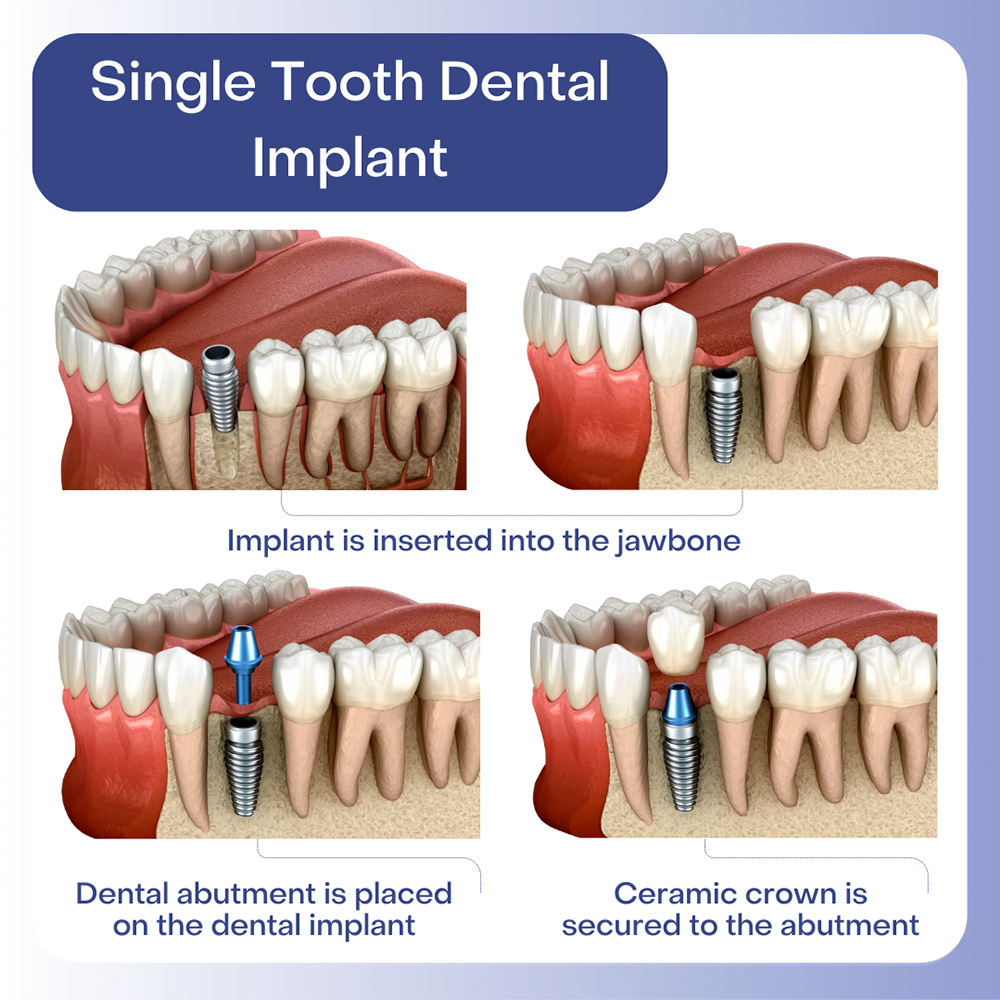The Basic Principles Of Dental Sense
The Basic Principles Of Dental Sense
Blog Article
Examine This Report about Dental Sense
Table of ContentsThe Buzz on Dental SenseWhat Does Dental Sense Do?Get This Report about Dental SenseThe Facts About Dental Sense Revealed
are medical tools surgically dental implanted into the jaw to bring back a person's capacity to chew or their look. They give assistance for synthetic (fake) teeth, such as crowns, bridges, or dentures. When a tooth is lost because of injury or condition, an individual can experience issues such as fast bone loss, defective speech, or adjustments to chewing patterns that result in discomfort.Oral implant systems include a dental implant body and dental implant joint and might additionally include an abutment addiction screw. Dental implants. The dental implant body is operatively inserted in the jawbone in location of the tooth's root. The oral implant abutment is usually connected to the implant body by the abutment addiction screw and prolongs via gum tissues right into the mouth to sustain the affixed fabricated teeth
(http://www.askmap.net/location/7224225/united-states/dental-sense)Structure of The Oral Implant System selecting oral implants, speak with your oral service provider about the prospective benefits and threats, and whether you are a candidate for the treatment. Points to think about: Your total health and wellness is an essential consider figuring out whether you are a good candidate for dental implants, the length of time it will certainly require to heal, and for how long the implant might remain in place.
Smoking may impact the healing procedure and lower the long-term success of the dental implant. The healing process for the implant body may take several months or longer, during which time you generally have a short-lived abutment instead of the tooth. the dental implant procedure: Very carefully follow the oral hygiene guidelines offered to you by your dental supplier.
The Basic Principles Of Dental Sense
Implant failing can cause the requirement for another surgical procedure to deal with or replace the dental implant system. Brings back the capacity to chew Restores aesthetic appearance Helps keep the jawbone from shrinking as a result of bone loss Maintains the health of the bordering bone and gum tissues Aids maintain nearby (nearby) teeth secure Enhances quality of life Damage to bordering all-natural teeth throughout implant placement Injury to the surrounding cells throughout surgery, such as sinus opening Injury during surgical treatment (for instance, fracture of bordering jawbone) Poor function, such as seeming like the teeth do not bite with each other typically A feeling that the tooth hangs or twisting in position resulting from an abutment screw loosening up Implant body failing (looseness of the dental implant body) because of systemic infection, which might be more probable in clients with uncontrolled diabetes as a result of regional infection in bone and periodontals supporting the dental implant body as a result of delayed healing, which may be more probable in people who smoke Difficulty cleansing the periodontals around the implant, causing bad oral hygiene Untreated gum illness Post-surgical feeling numb as a result of nerve impingement or damage Always inform wellness treatment providers and imaging service technicians that you have dental implants prior to any type of magnetic vibration imaging (MRI) or x-ray treatments.
FDA is not familiar with any kind of damaging occasions reported for MRI or x-ray procedures with oral implants. Oral implants systems are commonly constructed from products that adhere to global agreement criteria of the International Company for Standardization (ISO) or ASTM International. These criteria have details of what makes a secure product.

An oral implant is a structure that replaces a missing out on tooth. With screw-like devices, the cosmetic surgeon inserts an implant into the jawbone, and it functions as a support for a man-made tooth, called a crown. A gadget called an abutment links the synthetic tooth to the oral implant. The crown is personalized to fit the person's mouth and match the color of their teeth.
Some Known Details About Dental Sense
Some people are not qualified for oral implant surgical treatment. It is for dental doctors to operate people with: intense illnessuncontrollable metabolic diseasebone or soft tissue condition or infectionIf these concerns are dealt with, a person can have the surgery. In, dental doctors abstain from operating people with: If individuals with any one of the above go through oral implant surgery, there is a greater threat of the dental implant stopping working.

Dental implant surgical treatment is an individualized procedure. Offer you time to recover. Connect the post and last crown, bridge or denture.
Next, your surgeon will very carefully put the oral implant into your jaw. Your cosmetic surgeon will certainly reposition your gums and close the incision with stitches. If your implant is near the front of your mouth, your dental expert will make a temporary tooth for you to use until you recover. By doing this, you won't have a space in your smile while you recuperate.
How Dental Sense can Save You Time, Stress, and Money.
During the healing phase, your visit site jawbone ought to fuse to the oral implant. This procedure can take anywhere from three to 9 months.
Once your dental implant heals, your dentist can affix the joint (small port blog post) and your last remediation (crown, bridge or denture). This generally takes regarding one hour to complete and might call for a second small surgical procedure. You shouldn't really feel any kind of pain throughout your oral implant procedure because your service provider will utilize medicine to numb your gum tissues.
Report this page